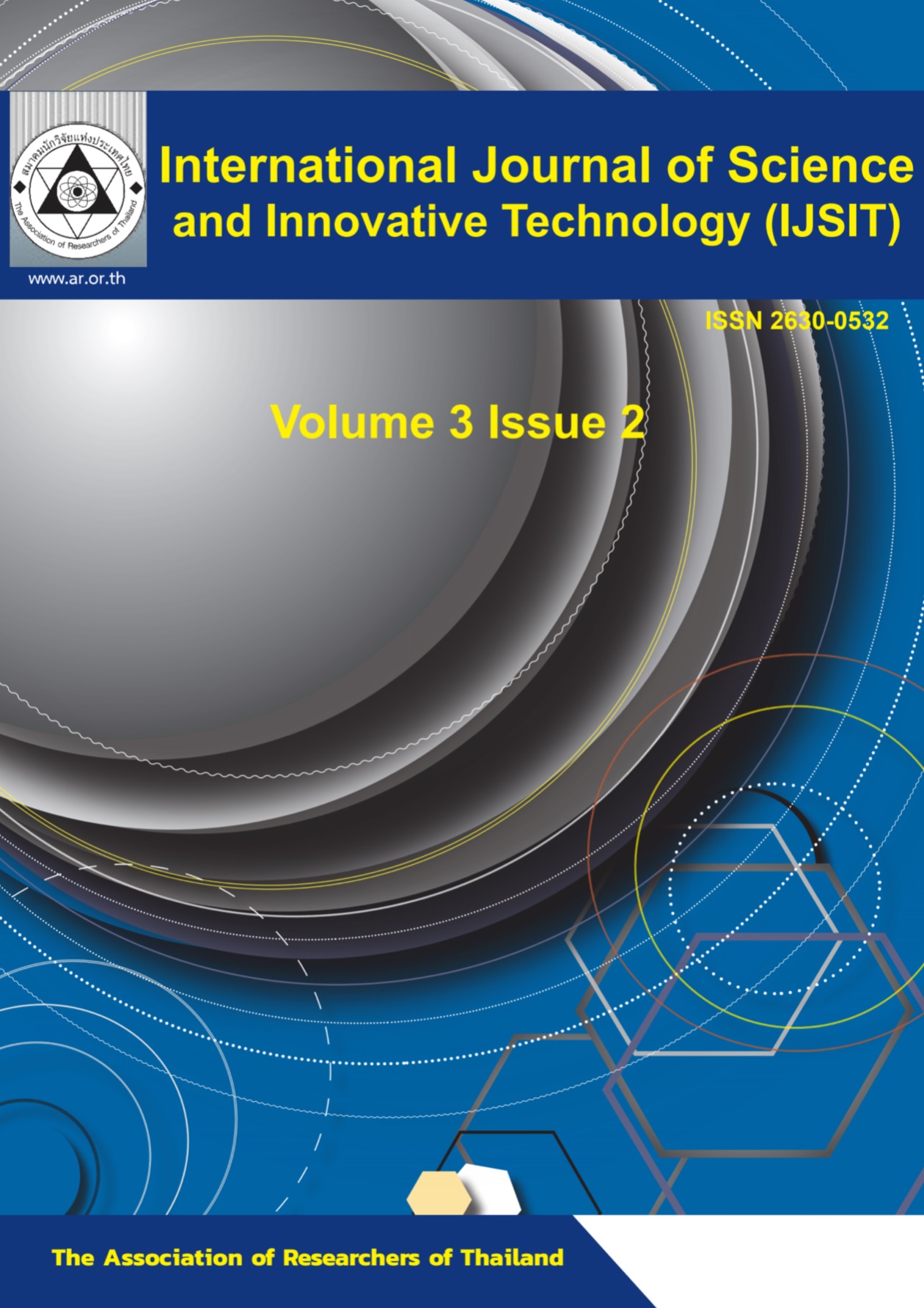Antimicrobial Activities and Metal Chelation Ability of New Water-Soluble Chitosan Derivatives Having N-carboxymethyl Groups
Main Article Content
Abstract
In this article, novel aminoamine grafted chitosans containing hyperbranched-N-carboxymethyl groups are synthesized, characterized and tested for their potential usage. The synthesis is achieved by, using a commercially available chitosan with known chemical conversions. Two successive steps, Michael addition of amino groups to methyl acrylates followed by amidation with ethylenediamine, are repeated to generate hyperbranched chitosans. Subsequent connection of N-carboxymethyl groups to the synthesized hyperbranched chitosans led to the modified chitosans containing hyperbranched-N-carboxymethyl groups. These novel modified chitosans are characterized by FTIR-UATR (Fourier transform infrared-universal attenuated total reflectance) and 13C CP/MAS (13C Cross polarization/magic angle spinning). The modified chitosans show significantly improved water solubility which is a highly desirable property for some applications, compared to the original chitosan. The antimicrobial activity test showed that the modified chitosans display higher efficiency for antimicrobial activity against Staphylococcus aureus ATCC 29213, Micrococcus luteus ATCC 10240 and Shewanella putrefaciens ATCC 8071 compared to the original chitosan. ICP-MS (inductively coupled plasma-mass spectrometer) analyses are used to confirm that these modified chitosans have superior affinity to chelate heavy metals, compared to the unmodified starting chitosan. These modified chitosans are considered high potential utilities for human life and environmental concern.
Article Details
References
Ahmad, M., Ahmad, S., Swami, B. L., & Ikram, S. (2015). Adsorption of heavy metal ions: Role of chitosan and cellulose for water treatment. International Journal of Pharmacognosy, 2(6): 280-289. https://doi.org/10.3390/polym10040389
Baumann, H., Faust, V. (2001). Concepts for improved regioselective placement of O-sulfo, N-sulfo, N-acetyl, and N-carboxymethyl groups in chitosan derivatives. Carbohydrate Research, 331, 43-57. https://doi.org/10.1016/S0008-6215(01)00009-X
Chanthateyanonth, R., Ruchirawat, S., & Srisitthiratkul, C. (2010). Preparation of new water‐soluble chitosan containing hyperbranched‐vinylsulfonic acid sodium salt and their antimicrobial activities and chelation with metals. The Journal of Applied Polymer Science, 116, 2074-2082. https://doi.org/10.1002/app.31732
Colo, G. D., Zambito, Y., Burgalassi, I., & Saettone, M. F. (2004). Effect of chitosan and of N-carboxymethylchitosan on intraocular penetration of topically applied ofloxacin. International Journal of Pharmaceutics, 273, 37-44. https://doi.org/10.1016/j.ijpharm.2003.12.018
Fréchet, J. M. J. (2003). Dendrimers and other dendritic macromolecules: From building blocks to functional assemblies in nanoscience and nanotechnology. Journal of Polymer Science Part A: Polymer Chemistry, 41, 3713-3725. https://doi.org/10.1002/pola.10952
Goy, R. C., Morais, S. T. B., & Assis, O. B. G. (2016). Evaluation of the antimicrobial activity of chitosan and its quaternized derivative on E. coli and S. aureus growth. Brazilian Journal of Pharmacognosy, 26, 122–127. https://doi.org/10.1016/j.bjp.2015.09.010
Gupta, V., Chauhan, A., Kumar, R. N. S., Dhyani, A., & Chakravarty, S. (2019). Meningitis caused by micrococcus luteus: Case report and review of literature. IP International Journal of Medical Microbiology and Tropical Diseases, 5(1), 63-64. DOI: 10.18231/2581-4761.2019.0015
Mourya V. K., & Inamdar N. N. (2008). Chitosan-modifications and applications: Opportunities galore. Reactive and Functional Polymers, 68, 1013-1051. https://doi.org/10.1016/j.reactfunctpolym.2008.03.002
Qin, C., Du, Y., Xiao, L., Liu, Y., & Yu, H. (2002). Moisture retention and antibacterial activity of modified chitosan by hydrogen peroxide. The Journal of Applied Polymer Science, 86, 1724-1730. https://doi.org/10.1002/app.11080
Qu, R., Sun, C., Ji, C., Wang, C., Chen, H., Niu, Y., Liang, C., & Song, Q. (2008). Preparation and metal-binding behaviour of chitosan functionalized by ester- and amino-terminated hyperbranched polyamidoamine polymers. Carbohydrate Research, 343, 267-273. https://doi.org/10.1016/j.carres.2007.10.032
Sashiwa, H., Yajima, H., & Aiba, S.-i. (2003). Synthesis of a chitosan−dendrimer hybrid and its biodegradation. Biomacromolecules, 4, 1244-1249. https://doi.org/10.1021/bm030021w
Sashiwa, H., & Aiba, S.-i. (2004). Chemically modified chitin and chitosan as biomaterials, Progress in Polymer Science, 29, 887-908. https://doi.org/10.1016/j.progpolymsci.2004.04.001
Sashiwa, H., Shigemasa, Y., & Roy, R. (2002). Chemical modification of chitosan 8: preparation of chitosan–dendrimer hybrids via short spacer., Carbohydrate Polymers, 47, 191-199. https://doi.org/10.1016/S0144-8617(01)00166-7
Shelburne, S., & Musher, D. M. (2011). Management of Gram-Positive Bacterial Disease: Staphylococcus aureus, Streptococcal, Pneumococcal and Enterococcal Infections. Principles and Practice of Cancer Infectious Diseases, 409–421. doi: 10.1007/978-1-60761-644-3_35
Song, Z., Li, G., Guan, F., & Liu, W. (2018). Application of chitin/chitosan and their derivatives in the papermaking industry. Polymers, 10, 389, https://doi.org/10.3390/polym10040389
Tsubokawa, N., &Takayama, T. (2000). Surface modification of chitosan powder by grafting of ‘dendrimer-like’ hyperbranched polymer onto the surface. Reactive and Functional Polymers, 43, 341-350. https://doi.org/10.1016/S1381-5148(99)00065-6
Vignier, N., Barreau, M., Olive, C., Baubion, E., Théodose, R., Patrick Hochedez, P., & Cabie, A. (2013). Human Infection with Shewanella putrefaciens and S. algae: Report of 16 Cases in Martinique and Review of the Literature. The American Journal of Tropical Medicine and Hygiene, 89(1): 151–156. doi: 10.4269/ajtmh.13-0055
Xing, R., Liu, S., Guo, Z., Yu, H., Wang, P., Li, C., Li, Z., & Liu, W. (2005). Relevance of molecular weight of chitosan and its derivatives and their antioxidant activities in vitro. Bioorganic&Medicinal Chemistry, 13, 1573-1577. https://doi.org/10.1016/j.bmc.2004.12.022


